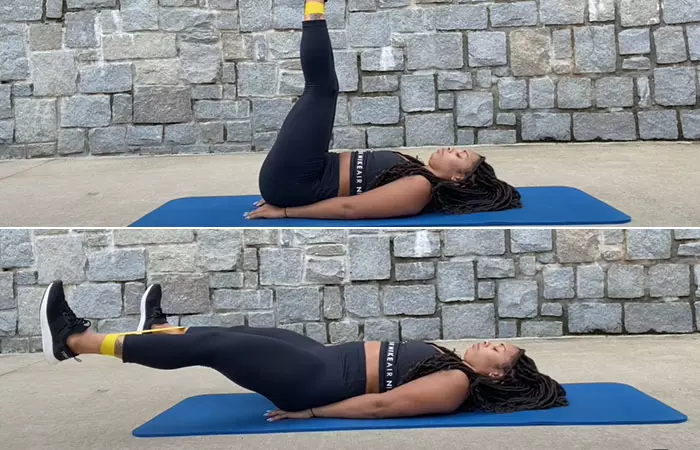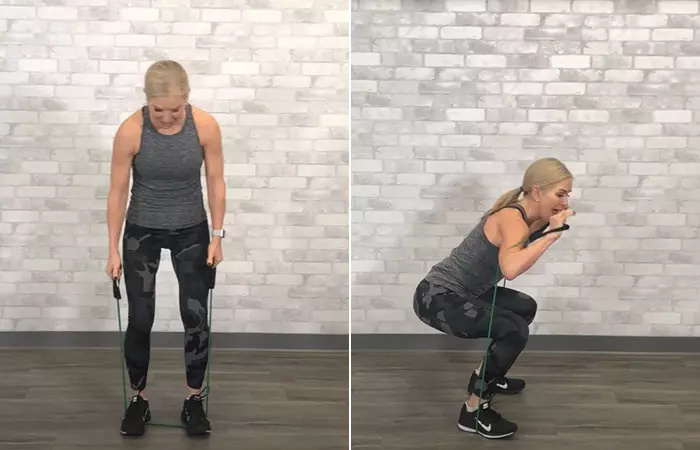16 Best Resistance Band Exercises To Build Abs & A Strong Core
Build a strong core and abs by adding this handy band to your workouts!

Image: Shutterstock
Exercising regularly can offer many health benefits, but many of us may find it difficult to stick to an exercise regimen with weights, especially when toning our abs. But worry not, as we have a solution – resistance band exercises! These bands are gaining popularity because of their offering, portability, and hassle-free use. They help improve mobility and flexibility and even play a role in physical therapy. Learn more about the 16 top exercises for abs using resistance bands.

 Workout Blueprint: Resistance Band Exercises To Build Abs
Workout Blueprint: Resistance Band Exercises To Build Abs- Frequency: 2-3 times a week
- Benefits: Target and tone small muscle groups and improve mobility and flexibility.
- Equipment Needed: Resistance band
- Space Required: Small space
- Assistance Required: No
- Who Should Avoid: Anyone with an acute injury, chronic medical condition, or joint problem.
In This Article
16 Resistance Band Exercises For Abs
1. Banded Bridge

- Select a resistance band with the appropriate strength that also suits your fitness level.
- Lie down on the floor, with your back straight, and stretch your knees at a right angle.
- Put the resistance band around your thighs and adjust it accordingly.
- Keep your arms on your sides and press your knees out against the bands.
- Raise your hips towards the ceiling. Squeeze your muscles tight, hold for 5 seconds, and release.
- Repeat the exercise 15 times.
 Quick Tip
Quick Tip2. Knee Pull-Ins

- This exercise majorly works the lower abs.
- Lie down on a gym mat and position your knees at a right angle.
- Adjust the resistance band over the knees and slowly pull in the right knee.
- Hold for a second and repeat the same with the left knee.
- Repeat 15 times.
3. Flutter Kick Crunches
- This exercise majorly works the lower abs.
- Tie the resistance band to your feet.
- Lie down on the gym mat.
- Slowly pull the resistance band and lift your right leg and left leg for a crunch.
- Repeat this continuously for 5 minutes. This completes 1 set.
- Perform at least three

4. Banded Bird Dogs
- Loop one end of the band around your right hand and the other end around your left foot.
- Simultaneously extend the arm and the banded knee slowly.
- Keep your spine stable while performing this move.
- Complete three sets with ten repetitions each.
- Change sides.

5. Double Leg Stretches

- Lie on your back with your legs slightly raised.
- Wrap the band around your feet, and loop the ends around your hands.
- While pulling your abs down toward the floor, extend the legs out and away from your midsection and slowly release.
- Perform 15 repetitions.
6. Russian Twists

- Start by sitting in a position with your knees bent and heels on the ground.
- Tie the resistance band around and under your knees, and hold one end with both hands.
- Grab your obliques and twist to the right side, pulling the band with you.
- Repeat on the left side.
- Perform 15 to 20 repetitions.
7. Side Plank Crunches

- Start with a side plank. Hold the resistance band with the lower hand, and grab the other end with the other hand. Ensure the band runs behind your back.
- Grab your core and drive your upper knee toward your chest.
- Return to the starting position.
- Complete ten reps on each side.
8. Pall Of Press

- Attach a band to any hard object (or a pole) at your shoulder height. Grasp the free end with one hand over the other and step away from the tie-up point to create tension in the band.
- Turn perpendicular to the tie-up point and extend your arms. The band will pull your body towards it.
- Bring your hands back to your chest and repeat.
- Perform eight reps on each side.
9. Bicycle Crunches

- Curl each end of a resistance band around your thighs.
- Lie flat on the floor and assume a bicycle crunch position. Lean back slightly, and place your hands behind your head with your elbows out.
- Push one leg out and simultaneously bring the other leg in, towards your chest. Slowly bring your elbow to the opposite knee at the same time.
- Repeat these crunches 10 times.
10. Single-Arm Shoulder Press

- In a standing position, place the band under one of your feet and hold the other end in one hand.
- Raise your arm above your head until it is well stretched.
- Do not bend your trunk to the side during this movement.
- Perform 10 to 15 repetitions.
11. Standing Knee Tucks

- Start the exercise by standing with your feet a little more than hip-width apart. Loop the resistance band around your shins.
- Lift your left knee toward your chest and crunch your right elbow towards your left knee.
- Try to touch the elbow with the knee without rounding your shoulders.
- Return to the original position and repeat on the other side.
- Repeat 8 to 10 times.
12. Tube Band Leg Press

- Loop a resistance band around your feet.
- Lie on the floor, face up
- Pull the resistance band slowly and pull in your legs slowly
- Press your legs and use your core to hold the position and repeat continuously
- Repeat 10 times.
 Quick Tip
Quick Tip13. Banded Plank

- Start by lying in a side plank position with the resistance band looped around your ankles.
- Shift your weight to the right hand and place the left hand on your hip.
- Raise your left hand vertically upwards.
- Raise your right leg too, such that the band is stretched.
- Stay in this position for a couple of seconds and return to the initial position.
- Repeat on the other side.
14. Leg Rises And Abductors

- Loop the resistance band around your ankles and lay back straight.
- Raise your legs completely and hold on for a second.
- Slowly lower your legs and widen them a little. Hold for a second and raise your legs again.
- Complete 10 repetitions.
15. Banded Squats

- Loop the resistance band around both your wrists.
- Bring the band to the floor and place both your feet on it. Draw your feet hip-width apart.
- Extend your arms straight and slowly move your hips back, keeping your chest lifted.
- Return to the starting position.
- Complete 5 reps, then repeat on the other side.
16. Glute Bridge

- Lie on your back and bend your knees, keeping them hip-width apart.
- Loop a resistance band around your thighs.
- Tighten your core by pulling your belly button towards your spine.
- Press your heels, squeeze your glutes, and raise your hips toward the ceiling.
- Ensure your knees are pushing against the band for resistance as you lift your hips.
- Hold the bridge position briefly at the top.
- Lower your hips to the starting position gradually. Make sure your butt does not touch the floor.
- Do this for 3–4 sets of 15–20 reps each.
Lydia, a blogger, recalled how a cardio core class she visited made use of rubber resistance bands a lot and she enjoyed it. Years later, when she was looking for an alternative to strength training, a friend suggested resistance bands. She writes, “I’ve been using the bands for several weeks now and I still think they are great (i).” She mentions using them to perform various exercises like squats, bicep curls, pelvic push, and side leg lifts.
This resistance band workout is sure to tone your abs. You can use a variety of resistance bands for performing ab-strengthening and core-strengthening exercises. We have discussed them in the next section.
Key Takeaways
- Banded bridge, knee pull-ins, flutter kick crunches, bicycle crunches, and standing knee tucks are some of the exercises you can do with resistance bands.
- You can use resistance bands if you find difficulty handling gym equipment.
- However, you should always follow the safety precautions while using resistance bands.
What Kind Of Resistance Bands To Use
- Power Loop Resistance Bands
These bands are generally 40 to 45 inches long. They are massive rubber bands. You can use them for warm-ups, full-body workouts, and pull-ups. They are popularized for their elasticity and durability.
- Mini Resistance Bands
You can also use a mini resistance band for shoulder and elbow stabilization. If you are into calisthenics, mini resistance bands are ideal for movements like muscle-ups and handstands. They can offer anywhere between 5 to 50 pounds of resistance.
- Tube Resistance Bands
These have handles on both ends that mimic gym machines. They are ideal for chest presses, curls, back rows, shoulder presses, and other exercises that involve pressing and pulling.
You can choose any of the above-mentioned resistance bands based on your fitness goals. But why even choose resistance bands for ab exercises? How are they useful?
Why Use Resistance Bands For Ab Exercises?
Using resistance bands can be beneficial for increasing strength. They also may help gain body mass (1). They can be used for both shoulder abductions and external rotations.
Resistance bands may also help in the treatment of musculoskeletal disorders. This ab exercise equipment helps activate muscles (2). Hence, they are also ideal for use during rehabilitation.
Resistance band exercises have also shown to improve cardiovascular health (3).
Using resistance bands is ideal if you find it difficult to handle gym equipment. The exercises using bands can be performed anywhere.
Hence, they could be a good workout partner for lower ab exercises for women and men alike.
But despite their benefits, resistance bands may also cause injuries at times. Hence, following the safety precautions is important.
Safety Tips For Resistance Band Workouts
- Check for the elasticity and safety of resistance bands.
- Do not perform resistant band exercises on uneven surfaces to prevent slipping.
- Do not stretch the bands beyond their specified length.
- Do not try to use a broken or repaired band. Check for any cracks/cuts on the band. If you observe any, do not use it.
- Do not use any resistance band beyond 8 to 10 months as it may break or lose its elasticity. Get a new band.
- Do not try to pull the band too tight near to your face.
Infographic: Resistance Bands Color Codes
Along with the various resistance bands you can use for your ab workouts, you must also know the basic color coding that determines their stretch, thickness, and resistance levels. Click on the infographic below to know more and pick the one best suited for your fitness levels.
Some thing wrong with infographic shortcode. please verify shortcode syntax
Resistance band exercises are the best for those individuals who hate hitting the gym and lifting weights for muscle building. You can do these exercises in the comfort of your home and achieve the much-evasive abs to look fitter and toner. Moreover, they are easy to perform and less likely to cause injuries, unlike strength training using weights. Make sure you invest in a good resistance band and always work out on an even, non-slip surface. Practice caution as stretching these bands beyond their capacity can cause them to snap and result in injuries.
Frequently Asked Questions
How long does it take to see results from using resistance bands?
You may notice positive changes within two to four weeks of regular resistance training. However, it may vary from person to person.
How many times a week should you use resistance bands for resistance training?
Using resistance bands 2-3 times per week for resistance training may offer significant health benefits. However, consult a fitness coach to determine the frequency and intensity based on your fitness level.
How do resistance band exercises compare to traditional weight lifting?
Resistance band exercises mainly target smaller muscles, while traditional weight lifting targets larger muscles.
What are some tips for choosing the right resistance band for your fitness level?
When choosing the right resistance band for your fitness level, look for the strength or tension of the band, check the resistance level, and choose the right size band that fits your body.
Q: How do you properly warm up before doing resistance band exercises?
You should start with light jogging and stretches before resistance band exercises to prevent injuries
Can resistance bands be used for rehabilitation or physical therapy?
Yes, resistance bands can be used for rehabilitation or physical therapy to help strengthen muscles and to improve the mobility and flexibility of specific joints or muscles.
Can resistance bands be used for cardio workouts?
Yes, resistance bands can be used for cardio workouts like jumping jacks for strength training.
What are some common resistance band exercises for beginners?
Squats, bicep curls, shoulder presses, lateral raises, and chest presses are some common resistance band exercises for beginners.
Personal Experience: Source
StyleCraze's articles are interwoven with authentic personal narratives that provide depth and resonance to our content. Below are the sources of the personal accounts referenced in this article.
i. Resistance band workoutshttps://buildingabetterlydia.com/2012/06/14/resistance-band-workouts/
References
Articles on StyleCraze are backed by verified information from peer-reviewed and academic research papers, reputed organizations, research institutions, and medical associations to ensure accuracy and relevance. Read our editorial policy to learn more.
- Elastic Resistance Effectiveness on Increasing Strength of Shoulders and Hips
https://www.ncbi.nlm.nih.gov/labs/pmc/articles/PMC5847412/ - Multiple-joint exercises using elastic resistance bands vs. conventional resistance-training equipment: A cross-over study
https://www.tandfonline.com/doi/full/10.1080/17461391.2017.1337229 - Effects of Elastic Band Exercise on Functional Fitness and Blood Pressure Response in the Healthy Elderly
https://pmc.ncbi.nlm.nih.gov/articles/PMC7579118/
Read full bio of Dhanashree Rabha
Read full bio of Ravi Teja Tadimalla
Read full bio of Himanshi Mahajan



























Community Experiences
Join the conversation and become a part of our empowering community! Share your stories, experiences, and insights to connect with other beauty, lifestyle, and health enthusiasts.